#t5 led
Explore tagged Tumblr posts
Text

Mẫu đèn tuýp led T5 1.2M 20W là mẫu sản phẩm được nhiều khách hàng sử dụng vì tính năng nhỏ ngọn và có thể nối liền tạo thành 1 dòng ánh sáng liên mạch dễ dàng sử dụng trong hắt khe nhỏ như hắt tường, hắt trần hay hắt kính.
0 notes
Text
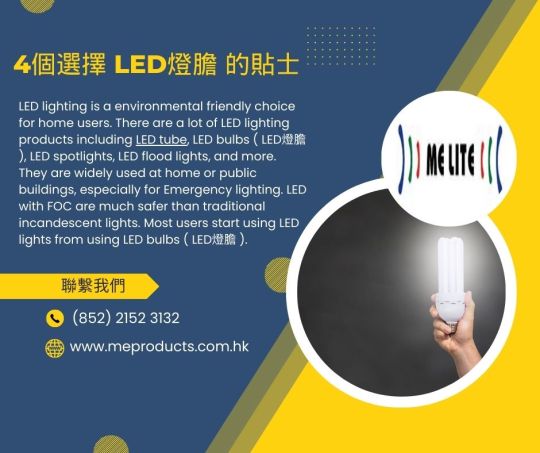
4個選擇 LED燈膽 的貼士
"4個選擇 LED燈膽 的貼士: 1/ LED燈膽的壽命 (LED Life) 大部分 LED燈膽 都標籤擁有10000小時的壽命,但其實真正的使用壽命並不準確。 香港一個對10款LED燈膽的測試指出,該標籤的壽命是根據製造商的不同測試標準而建議的。 需要根據使用的方法及電流而定。 2/ LED燈膽 的 插頭 (LED Bulb Head Types) 選購合適的 LED燈膽 務必要根據你的燈是使用哪一款插頭而定。 * E14 小型螺絲頭 * E27 大型螺絲頭 * B22 釘頭 3/ LED燈膽 的流明度 (LED Bulb Luminosity) LED燈膽 是以 流明度 (Luminosity或 Lumen; lm) 來量度光度。 流明度越高,發出的能量就越大 4/ LED燈膽 的 色溫 (LED Bulb Temperature) LED燈膽 的 色溫 以K來量度。 當色溫少於 3500k,顏色會較偏向暖色 當色溫介乎於3500k-5000k,顏色會較冷及較白 當色溫搞於5000k,顏色會較藍的偏冷色"
0 notes
Link
The Ultimate Guide To Fluorescent Replacement With LED Retrofit Light Tubes
You see, converting your lighting systems by switching over to LEDs is a cost-efficient project. So much so that you can completely transition to LEDs in your home for well over $1000.
On top of that, residential (and commercial) LED solutions also carry a high return on investment. And you can avail of it by not only recovering the upfront costs but also saving on your utility bills.
Impressive, isn’t it?
If you’re looking for such affordable and high-return fluorescent replacements with LED light tubes, you can reach out to us.
At Eco-$mart Inc, we have the largest inventory of fluorescent fixture-compatible LED tube lights readily available at the most competitive prices.
Also, we have the most innovative and eco-friendly lighting products in the form of solar-powered LED lamps and more. So whatever your lighting requirement is, we have got you covered.
0 notes
Note
I want to know your thoughts on the mock draft !!!

LEMME GET INTO ITTTTT
why this guy paige at #1 she’s so mid bro
nah 1 and 2 solid
but after that it gets kinda dicey
if y’all seen olivia miles play, you know she’s a DAWG like… we’re talking second team all america, preseason watchlists, like she can HOOP
but that injury bug… there’s people ahead of her in this draft in my mind, like 3 is crazy - i think olivia, azzi, and rori in that order at 5,6,7 ish
and imma explain about azzi before y’all get too tight like CHILLLLLL you know azzi’s my girl
i think that 3 spot should be aneesah’s… she’s so stupid underrated even after going to lsu, and i think w angel in the league she’s going to be a more prioritized scoring option for them. this girl is a PURE HOOPER; the fact that mulkey lowk had mikayla williams as the second/third option over her is nuts - esp when she literally averaged a double double on a team WITH ANGEL REESE
idk ab this french girl like who knows overseas is not my circus but te-hina paopao is EASILY a top 4-8 pick. this is NUTS. this girl LED THE COUNTRY in 3pfg we NEED some respect here like godDAMN
i put raven at 8, bc yes she’s a DAWG but putting her OVER te-hina paopao is luuuudicrous to me
saniya rivers is also way too low, and bro imma be SO FUCKING FR: georgia amoore is not a first round pick imo. maybe literally dead fucking last but anything other than that is… nah bro. that’s nuts. high second round sure. but first round OVER SANIYA RIVERS?? fuck outta here.
lemme speak on rori and azzi rq
coming out of high school: both of them, i would’ve said t5 easy, azzi goes first (paige out of the picture ofc)
but there’s that injury bug again and when you’re not paige bueckers, it fucks with your draft stock.
now rori only has one year of injury, and she’s recovering fast (or forcing a speedy recovery, which is just stupid, but we’ll see which one it is) but azzi on the other hand… she’s never even played a full season of college basketball
but i still take azzi over rori, even after the way rori shut down uconn’s defense this past season, because a healthy azzi fudd is just that good
if she stays healthy this season, and she’s playing as good as i KNOW she can, azzi’s a top 3 pick easy
as it stands RIGHT NOW THO - azzi sitting at a healthy 5-8 is fair
and if she waits another year, and she goes with flau’jae’s class - i can see her fighting flau or lauren or cotie for that number one spot and winning out
but i’m thinking from like a cost benefit analysis standpoint - if azzi plays a full season of college basketball, absolutely smokes bitches, brings home that natty… the 3 spot is hers. if i’m azzi - i declare right after the natty, or even before depending on how my season’s going. imma keep it a buck - i wouldn’t risk the extra season of college ball when i know i’m essentially guaranteed a roster spot in the w
#wbb#women’s basketball#wcbb#wnba#wnba draft#paige bueckers#azzi fudd#kiki iriafen#georgia amoore#ncaaw#ask
50 notes
·
View notes
Text
Important to understand why plants need light to grow
In recent years, indoor gardening has become increasingly popular among plant enthusiasts. Whether you live in a small apartment with limited sunlight or want to grow plants year-round, grow lights have become an essential tool for ensuring your plants receive the light they need to thrive. In this blog post, we will explore the world of grow lights for plants, discussing the different types available and how to choose the right one for your indoor garden.
First, it's important to understand why plants need light to grow. Light is an essential element for photosynthesis, the process by which plants convert sunlight into energy. Without adequate light, plants will struggle to thrive, resulting in stunted growth, poor flowering, and overall lackluster health. When growing plants indoors, it's crucial to provide them with the right amount and quality of light to mimic the conditions they would experience outdoors.
There are several types of grow lights available on the market, each with its own strengths and weaknesses. Here are some of the most common types:
1. Fluorescent grow lights: These are a popular choice for indoor gardeners, as they are affordable, energy-efficient, and produce a wide spectrum of light that is suitable for most plants. Fluorescent lights come in two main varieties: T5 and T8. T5 lights are more efficient and produce higher light output, making them ideal for larger plants or multiple plants. T8 lights are less efficient but are still a good option for smaller plants or seedlings.
2. High-intensity discharge (HID) grow lights: HID lights are known for their high light output and are a favorite among professional growers. There are two main types of HID lights: metal halide (MH) and high-pressure sodium (HPS). MH lights emit a bluish-white light that is ideal for vegetative growth, while HPS lights produce a reddish-orange light that is best for flowering and fruiting plants.
3. LED grow lights: LED lights are a relatively new technology in the world of grow lights, but they have quickly gained popularity due to their energy efficiency and long lifespan. LED lights come in a variety of colors and spectrums, allowing you to customize the light output for different stages of plant growth. While LED lights tend to be more expensive upfront, they can save you money in the long run due to their low energy consumption.
When choosing a grow light for your indoor garden, there are several factors to consider. First, consider the type of plants you are growing and their specific light requirements. Some plants, such as leafy greens and herbs, may thrive under lower light levels, while fruiting plants like tomatoes and peppers will require more intense light. Additionally, consider the size of your growing space and how many plants you will be growing. Make sure to measure the light output of the grow light to ensure it will provide adequate coverage for your plants.
In conclusion, grow lights are an essential tool for indoor gardeners looking to grow healthy, vibrant plants year-round. With the wide variety of options available on the market, it's important to do your research and choose a grow light that best suits your plant's needs and your growing space. Whether you opt for fluorescent, HID, or LED lights, providing your plants with the right amount and quality of light will help them thrive and flourish. Happy growing!
2 notes
·
View notes
Text
Skywalker OG number 2 ♀️ flower week 7 day 48 🪴 65 days in soil 😁 pollinated with a 90s Blues ♂️
More details 👇
This is a clone of a clone being flowered next to a ♂️ 90s Blues plant to produce Skywalker OG x 90s Blues seeds. This should be interesting because the Skywalker OG number 2 ♀️ is very bushy phenotype with a lot of purple and a very sweet flavor.
Mother plant:
Strain: Skywalker OG number 2 (clone of seed)
Date cut: 12/13
Days in cloner: 18 days
Date put in soil: 12/31
This clone:
Date cut: 1/27
Days in cloner: 14 days
Date put in soil: 2/10
Days in veg: 17
Date put in bloom: 2/27
*Days in bloom: 48
*Total days in soil: 65
Cloner: OxyCloner
Clone nutrients: Clonex clone solution (aeroponic cloner strength)
Light: Super Sprouter T5 high output 18"
Light reflector: NanoTech T5 reflector
Wattage: 17 watts
Light distance: 6.5 inches above cloner
Hardening environment:
Light: 9000k Clone LED from Luxx lighting (18 watt)
Side lights (2x): full spectrum LED Grow Light by Barrina (10 watt each)
Light distance: 6.5 inches
Medium: 70/30 coco perlite by Mother Earth
Early veg environment:
Light: SP150 from Mars Hydro (135 watt)
Light distance: 16.5 inches
Current environment:
Light: TSL-2000 from Mars Hydro (300 watt)
Light distance: 16.5 inches
Medium: 100% coco by Mother Earth
History:
Day 16 transplanted to 2 gal fabric grow bag
Day 17/f0 put into bloom tent with 90s Blues ♂️
Day 30/f13 put into larger 2x5 tent under SP3000 light
thanks for reading this far ☺️
much love ✌️
Reminder / disclaimer ⚠️ NFSOT (not for sale or trade) ⚠️ MEDICAL GARDEN ⚕️
The pictures or video in this post are taken by me and the plants are grown by me in a legal state while maintaining a medical recommendation (MMJ patient since 2000, with an OCBC member number under 4000, and a 99 plant growers certificate). I am posting the pictures as art and for educational purposes. More info & resources at LURK24 dot com
#cannabis #ᴡᴇᴇᴅᴘᴏʀɴ #420photography #homegrown

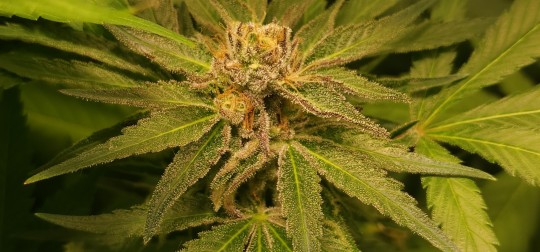
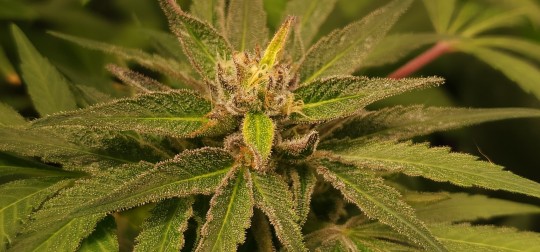






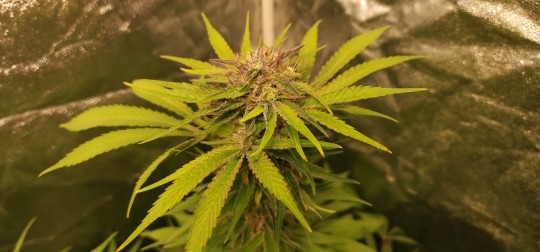
4 notes
·
View notes
Text























Pick of the day - dal mio blog stefanorossiautomotiveinternational.blogspot.com . La mia scelta del giorno ricade oggi su una VOLVO V60 seconda serie - o serie attualmente in produzione. Si tratta, nella fattispecie, di un 2.0 T5 turbo benzina da 250cv con trazione integrale AWD, cambio automatico ed allestimento intermedio (ma dotato di tutto quel che serve) Business Plus. Immatricolata nel maggio 2020, con soli 53.000 km all'attivo, dotata di clima automatico bizona, cruise control, navigatore, cerchi in lega da 18 pollici, fari a LED, portellone ad apertura elettrica, svariati sistemi di assistenza alla guida, Drive Mode, specchietti richiudibili elettricamente ed altro ancora - viene messa in vendita da PENSKE CARS, gruppo plurimandatario con vettura visibile presso loro showroom di Desio (MB), a 26.900,00 euro. Già, l'usato ha il suo perché. Stefano Rossi - blog's author.
0 notes
Text
Vivo T5 5G Price in Bangladesh 2024

Vivo T5 5G Price in Bangladesh 2024
Moble Phone's, Vivo Phone, Vivo T5 phone / Leave a Comment
Smartphones are very popular among the smart devices that have made all internet tasks easier in the digital age. Nowadays, all kinds of work can be done on smartphones.
Among the smartphones that are popular in the market today, Vivo is one of the famous brand smartphones. The number of buyers of this brand of phone is high as expected. There is no one in the world who does not know or know about Vivo smartphones.
Vivo T5 phone of Vivo brand is very popular with attractive features. As good as it looks, it performs as well. All in all, the Vivo T5 5G phone is currently the best of the best in terms of price, color and design.
Vivo T5 smartphone price is affordable. The phone is available in the market at a very moderate price. This makes it easier for everyone to buy this phone. This phone has some interesting features which are at par with big computers or laptops today. And since the smartphone is small and light, it can be carried in the hand or in the pocket.
Vivo T5 5G phone's camera will beat even the famous DSLR camera in taking pictures. Taking photos and videos with this phone's camera feels absolutely alive. Besides, it is quite popular among photographers as well as gamers. This phone can be used for Gmail, email, video recording, audio recording, taking pictures, playing games and high speed internet very easily. That's why it gained popularity without coming to the market.
The Vivo T5 5G smartphone is expected to run on Android version 14. And with that, there will be a 5000 mAh battery. And there will be super fast charger with great speed. Which has a capacity of 77 watts. It is expected that this phone will have 8GB of RAM. There are also some other special features in this phone. So let's know the price of this phone and what are the features?
Display:
Size - 6.7”
Type - AMOLED
Pixel Density - 395 ppi
Ratio - 20:09
Screen Design - Punch hole
Refresh - 120 HZ
Camera:
Camera Setup - Dual Camera, 50mp+5mp
Video - 3840×2160 @ 30 fps
Features - Digital zoom, auto flash, face detection, LED flash
Memory:
Ram - 4/8 GB
Rom - 128 GB
Storage Capacity - 1 TB
Performance:
GPU - Mali-G610 MC4
CPU - Octa-Core (dual Hexa core, Cortex A715, Cortex A510)
OS - Android V-14
User interface - Funtouch OS
Architecture - 64 bit
Design :
Water Resistant - Yes, splash proof, IP54
Battery:
Type - Li-polymer Non-removable
Capacity - 5000 mAh
Charger - Flash, 77W
Sensors:
Fingerprint type - Side
Other - Light sensor, proximity sensor, compass, Gyroscope
Network:
GPS - Yes
Network support - 4G/5G
SIM - Dual Nano SIM
WiFi features - Mobile Hotspot
Vivo T5 5G price in Bangladesh 2024-
৳39,990 BDT.
0 notes
Text
How to Dispose of Fluorescent Bulbs? Get Rid of CFL Lights.
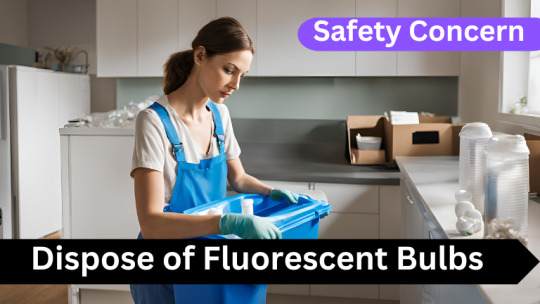
Fluorescent bulbs contain small amounts of mercury, How to Dispose of Fluorescent Bulbs is a challenging and important also essential to prevent environmental harm. Recycling through local waste programs or retailers ensures safe handling. Avoid throwing them in regular trash to reduce mercury pollution. Fluorescent lamps have been a popular choice for energy-efficient lighting for many years. However, with their widespread use comes the responsibility of safe disposal of CFL Lamps. These bulbs contain mercury, a hazardous material, which makes their proper disposal essential for protecting the environment and human health. In this gadget guide, we will cover everything you need to know about fluorescent bulbs—from their definition and types to their proper use, cost-efficiency, and the best practices for safe disposal.
What Are Fluorescent Bulbs?
Fluorescent bulbs are a type of light bulb that produces light through a chemical reaction involving electricity and mercury vapor. The electric current excites the mercury vapor, which produces ultraviolet (UV) light. This UV light then interacts with a phosphor coating inside the bulb, creating visible light. Fluorescent lighting is highly energy-efficient and lasts much longer than traditional incandescent bulbs, making it a popular choice for both residential and commercial use. Find Some Home Lights How to Shop Floor Lamp for Bedroom? The Genuine Guide What is Himalayan Salt Lamp? Best Healing Lamp. What are Epic Waterproof Outdoor LED Flood Lights Bulbs? Common Types of Fluorescent Lamps: - Compact Fluorescent Lamps (CFLs): These are smaller, spiral-shaped bulbs commonly used in homes as an energy-saving alternative to incandescent bulbs. CFLs are often found in table lamps, ceiling fixtures, and outdoor lighting. - Linear Fluorescent Tubes: These are long, tube-shaped bulbs, frequently used in offices, warehouses, and industrial spaces. The most common sizes are T5, T8, and T12, each referring to the diameter of the tube. - Cold Cathode Fluorescent Lamps (CCFLs): These bulbs are often used in specialized applications, such as in older LCD screens or for accent lighting in homes. Proper Use of CFL bulb Fluorescent bulbs are designed to be energy-efficient, consuming about 75% less energy than incandescent bulbs and lasting up to 10 times longer. To make the most out of your fluorescent bulbs, follow these tips: - Choose the right fixture: Use fluorescent bulbs in fixtures that are left on for extended periods, like kitchens, bathrooms, or garages. Frequent switching on and off can shorten their lifespan. - Avoid extreme temperatures: Fluorescent bulbs tend to work best in moderate temperatures. Extremely cold environments can affect their performance. - Use compatible dimmers: Not all fluorescent bulbs are compatible with dimmer switches. If you want dimming functionality, be sure to select a dimmable CFL or linear fluorescent bulb.
How do You Get Rid of Fluorescent Bulbs?
To properly get rid of fluorescent bulbs, it’s important to recycle them rather than throw them in the regular trash. Fluorescent bulbs contain small amounts of mercury, a toxic substance that can be harmful to the environment if released. Many municipalities and home improvement stores, such as Home Depot and Lowe’s, offer recycling programs specifically for fluorescent bulbs, ensuring they are handled in a way that prevents mercury contamination. Additionally, local hazardous waste collection events are another way to dispose of these bulbs safely. Recycling centers that specialize in electronic and hazardous waste are also equipped to process fluorescent bulbs properly.If recycling programs aren’t available in your area, you can opt for mail-in recycling services. Do you have these repairing tools in your store? Understand importance cleaning tools that must have. These programs provide a prepaid container, allowing you to send your used bulbs to facilities that can safely recycle them. In any case, it’s crucial to avoid breaking the bulbs, as mercury can escape and contaminate the air or nearby surfaces. By recycling fluorescent bulbs through appropriate channels, you are not only protecting the environment but also complying with laws in many areas that prohibit the disposal of hazardous waste in landfills. Source: Recycling and Disposal of CFLs and Other Bulbs that ... by US Gov Why Is Proper Dispose of Fluorescent Bulbs Important? The primary reason fluorescent bulbs require special disposal is that they contain mercury, a toxic heavy metal. Even though the amount of mercury in a single bulb is small (usually around 4-5 milligrams), the cumulative effect of improper disposal can be devastating to the environment. When fluorescent bulbs are thrown into regular trash and end up in landfills, they can break, releasing mercury into the soil and water. This can contaminate local ecosystems and pose serious health risks to humans and wildlife. Therefore, recycling or disposing of Fluorescent Bulbs through proper channels is not only an environmentally responsible practice but also a legal requirement in many areas. More about Home Lights: What Are the Best Outdoor Solar Fairy Lights? How LED Solar Table Lamp for Living Room Flashed How to Choose New Solar Lamp for Outdoor Lights? How to Safely Dispose of Fluorescent Bulbs Recycling Programs for Fluorescent tube Most municipalities have dedicated recycling programs for fluorescent bulbs. Some home improvement stores, like Home Depot and Lowe’s, offer in-store recycling options for CFLs and other fluorescent bulbs. When you take your old bulbs to these programs, they are safely processed, and their components are either recycled or disposed of without harming the environment. Hazardous Waste Collection Events Many communities organize hazardous waste collection events where residents can drop off items that contain harmful materials, including fluorescent bulbs. These events are an excellent way to dispose of multiple bulbs at once, along with other household waste like paint, batteries, and electronics. Specialized Recycling Centers for Some cities have recycling centers that specialize in handling hazardous materials, including fluorescent bulbs. These centers are equipped to manage and recycle bulbs in a way that prevents mercury from contaminating the environment. Mail-In Recycling Programs fo CFL Bulbs For those who don’t have access to a local recycling center or collection event, some companies offer mail-in recycling programs. These programs provide a prepaid shipping container, allowing you to send your used fluorescent bulbs to a facility that can safely recycle them.
What Should I Do If a Fluorescent Bulb Breaks?
Accidents happen, and sometimes fluorescent bulbs can break. Since they contain mercury, it’s crucial to handle broken bulbs with care. Here’s how to clean up a broken fluorescent bulb safely and Dispose of Fluorescent Bulbs: - Ventilate the Room: Immediately open windows and doors to allow fresh air to circulate. Leave the room for at least 10-15 minutes to let any mercury vapor dissipate. - Avoid Using a Vacuum: Vacuuming can spread mercury particles into the air. Instead, use stiff paper or cardboard to carefully scoop up the broken glass and powder. - Clean the Area: After picking up the large pieces, use sticky tape (like duct tape) to collect smaller fragments and powder. Wipe the area with a damp paper towel. - Seal the Debris: Place the broken pieces, powder, and cleaning materials in a sealed plastic bag. Dispose of this bag at a hazardous waste facility or recycling center. - Wash Your Hands: After cleaning up the broken bulb, wash your hands thoroughly with soap and water.
Best Practices for Dispose of Fluorescent Bulbs and Usage
To minimize the environmental impact of fluorescent bulbs, it’s crucial to handle both their use and disposal responsibly. Start by switching to more eco-friendly alternatives like LED bulbs, which are mercury-free, even more energy-efficient, and longer-lasting. When using fluorescent bulbs, handle them with care to prevent breakage, and store used bulbs safely until they can be properly recycled. Avoid throwing fluorescent bulbs into regular trash, as this can lead to mercury contamination in landfills. Instead, take advantage of local recycling programs, hazardous waste collection events, or mail-in recycling services that ensure safe disposal of Fluorescent Bulbs. By following these dispose of Fluorescent Bulbs practices, you can significantly reduce the negative impact of fluorescent bulbs on the environment. Switch to LED Bulbs: While fluorescent bulbs are energy-efficient, LED lights offer an even more sustainable option. They do not contain mercury, last longer, and use less energy. Switching to LED table lighting can significantly reduce your environmental footprint. Store Used Bulbs Properly: If you cannot immediately recycle your used bulbs, store them in a safe place where they won’t break. Consider labeling the container as "Hazardous" to remind yourself or others that these bulbs need special disposal. Educate Others: Spread awareness about the importance of properly disposing of CFL bulbs. Encourage your friends, family, and coworkers to recycle their bulbs to prevent mercury from contaminating the environment. Handle with Care: When installing or removing fluorescent bulbs, handle them gently to avoid breaking them. A broken CFL bulb not only creates a safety hazard but also requires careful cleanup due to the presence of mercury. read this How to Dispose of Fluorescent Bulbs? guide before touching broken mercury-based bulbs. Still about Home Lights Why Vintage Mushroom Lamp is so Popular in Home Decor? Why Sunset Lamp Is Big Trend in Home Lighting? Lutron Smart Switch vs. Traditional Switches: Why Upgrading is Worth?
Conclusion of How to Dispose of Fluorescent Bulbs?
Fluorescent bulbs have been a valuable Energy-efficient light solution for years, but their mercury content makes proper disposal critical. Recycling fluorescent bulbs through local programs or specialized recycling centers is essential to protecting the environment. By following the guidelines outlined in this article, you can ensure the safe use and ideas for Dispose of Fluorescent Bulbs while minimizing their impact on our planet. We hope we have provided some valuable information in our guide: How to Dispose of Fluorescent Bulbs? This will help you to get rid of retired Fluorescent Bulbs.
FAQs
Can I Dispose of Fluorescent Bulbs in the regular trash?No, it’s not advisable to Dispose of Fluorescent Bulbs in the regular trash. Doing so increases the risk of mercury contamination. Instead, take them to a recycling center or use a hazardous waste disposal service.Where can I recycle fluorescent bulbs?Many home improvement stores, such as Home Depot and Lowe’s, offer in-store recycling programs for the disposal of Fluorescent Bulbs. You can also check with your local government for hazardous waste collection events or recycling centers in your area.How much mercury is in a fluorescent bulb?A typical CFL contains around 4 milligrams of mercury, while larger linear fluorescent tubes may contain slightly more. Although this amount is small, mercury is highly toxic. And the Dispose of Fluorescent Bulbs is critical to preventing environmental contamination.Can I use fluorescent bulbs in cold environments?Fluorescent bulbs can be less efficient in cold temperatures, especially if the temperature drops below freezing. If you need lighting for cold environments, consider using LED bulbs, which perform better in extreme temperatures.Are there any alternatives to fluorescent bulbs?Yes, LED bulbs are an excellent alternative to fluorescent lighting. They are even more energy-efficient, mercury-free, and have a longer lifespan. Many people are transitioning from fluorescent to LED bulbs for these reasons.Is it illegal to throw away fluorescent bulbs?In many regions, it is illegal to Dispose of Fluorescent Bulbs in the trash due to the hazardous mercury content. Laws vary by location, so it’s important to check your local regulations.What should I do if I don’t have a recycling program nearby?If there’s no local recycling program, you can look for mail-in recycling services that allow you to send your used bulbs to a facility that can safely process them. These services often provide prepaid containers for shipping the bulbs for Dispose of Fluorescent Bulbs. Read the full article
0 notes
Text
0 notes
Text

【虛擬拍攝新趨勢:加入 LED螢幕 技術】LED屏幕 將取代傳統綠幕
"近年 LED螢幕 技術急速發展,影視製作團隊積極採用最新的 LED屏幕 取代傳統綠幕,用於虛擬拍攝製作(Virtual Production),亦促使虛擬拍攝成為影視行業的新工作模式。過去三年的疫情的確令拍攝團隊在戶外取景困難,加上經濟不景氣,不少電影投資者對投放大量資源於海外外景拍攝卻步。 發展成熟的LED顯示器技術是解決此問題的關鍵技術,既可即時播放劇情所設定的背景,演員亦可以在虛擬的空間演出,大大增加拍攝的創意和彈性,將不可能的拍攝變得可能,及減低拍攝合後製的時間和成本。"
0 notes
Link
The Ultimate Guide To Fluorescent Replacement With LED Retrofit Light Tubes
You see, converting your lighting systems by switching over to LEDs is a cost-efficient project. So much so that you can completely transition to LEDs in your home for well over $1000.
On top of that, residential (and commercial) LED solutions also carry a high return on investment. And you can avail of it by not only recovering the upfront costs but also saving on your utility bills.
Impressive, isn’t it?
If you’re looking for such affordable and high-return fluorescent replacements with LED light tubes, you can reach out to us.
At Eco-$mart Inc, we have the largest inventory of fluorescent fixture-compatible LED tube lights readily available at the most competitive prices.
Also, we have the most innovative and eco-friendly lighting products in the form of solar-powered LED lamps and more. So whatever your lighting requirement is, we have got you covered.
#LED Tube Lamp for T5#LED T8 Tube Lamp#10 Benefits Of Installing LED Lamps#LED light tubes#lighting solutions
0 notes
Note
Very simple, straightforward care: pot it up in a deep, non-terracotta pot of a safe substrate (long-fiber sphagnum moss, a 50/50 mixture of peat and perlite, or sphagnum + perlite, /no added minerals or fertilizer/), then put it outside in the sun. Full, direct sun, though with a week or so of acclimation in the shade if it's been on a store shelf. If you [general] can't do that, put it very close to a LED grow light. Windowsills are usually not bright enough long-term, as modern glass tends to filter out too much light.
Keep it in a tray of safe water, as said above. You want the substrate to be about as wet as a sponge that's been run under the tap and then wrung out. They do tend to rot if kept too wet, so you want the tray to be relatively shallow- 1/2 to 1 inch of water for a 5-6" pot is usually good.
In winter, reduce watering, and shorten their photoperiod if indoors. You don't actually have to put them in the fridge- most places, they can happily overwinter outdoors. As long as they don't freeze solid for days on end, they're fine, as they're from North Carolina and it does get cold there. A cold garage or cold windowsill can work if you live somewhere that does actually get too cold for them. Fridge dormancy should be considered a last resort, as they're prone to fungus without airflow. I'm not actually sure if that one in the picture is dormant- it looks just plain dead. There should be a visible live growth point, and the growth point there is black.
I've used this light https://www.amazon.com/gp/product/B0BGXQG748 to successfully grow flytraps indoors, hung about 6 inches above the surface of the pot. It has two heads and thus will support two pots. You can also get larger LED fixtures, or a simple T5 light fixture, for more plants.
Contrary to what some places will tell you, they don't like terrariums- not enough air flow, usually not enough root space, stagnant substrate, other terrarium inhabitants don't tend to like the dormancy. They also have no particular humidity requirement, as long as their substrate is damp.
I do second the recommendation for sundews. Cape sundews are probably the easiest, and most satisfying to grow, as they come in several varieties and get large. Care for those is even simpler: put their pot in a tray of water, put the pot in your brightest windowsill, keep water in the tray. No dormancy, no full-sun requirements. Capes will also grow fine in a terrarium if you like the look, though they'll probably need an LED light, as they benefit from more light than a terrarium can get from sunlight without cooking. Spoonleaf sundews, D. spatulata, are another easy one, and I believe are what Bogleech has? They're smaller, and their different varieties are more similar to each other than different varieties of capes are, but they're cute and easy. Same care. You can pot 'em with capes if you like.
EDIT: feeding! Flytraps don't eat to stay alive like animals do, they eat to grow. They'll grow slowly, but do fine, without food. They also catch flies on their own very reliably outside and fairly reliably indoors. If yours isn't catching any, freeze-dried bloodworms sold as fish food, soaked to rehydrate, will work. You do have to come back and squeeze the closed trap about 5min after feeding to trigger the hairs and convince the plant it has live prey. Sundews can have food sprinkled on them, or will catch gnats very successfully.
EDIT AGAIN: https://www.flytrapcare.com/phpBB3/forum.html is good for info and troubleshooting, or r/SavageGarden if you're on Reddit.
Hey Bog! Just got some Venus flytraps and was wondering if you had any advice on how to take care of them, what to feed them, etc. Any help would be appreciated!
Unfortunately, I'm not good at keeping them alive! They're a tricky thing to master. All fly traps technically need to be allowed to go dormant during the winter, which means they turn black and look like they've rotten away but the root bulb is just hibernating.

Since they also get sold as novelty plants with only minimal care instructions, there's probably millions of people a year who just think their fly trap "died" and throw it out at this stage. What you're meant to do is keep them cold and damp all winter, like wrapped in plastic in the refrigerator, then bring them back out in the spring and let them revive, though I've never gotten one to come back from the dormancy myself; I think fungus always kills mine, or the area I live just doesn't get bright enough because they like INTENSE direct sunlight. The #1 rule with fly traps and almost all carnivorous plants though is that they grow in bogs, so their roots want to be completely soggy at all times. It's best to keep a potted flytrap in a slightly wider pot and fill that pot with water. But it also has to be exactly the right kind of water!

Carnivorous bog plants evolved for high acidity, low nutrient, low mineral water and that can only be replicated with either store-bought "distilled" water, water from a Reverse Osmosis device, or freshly collected rainwater. Literally any other water will just kill a carnivorous plant completely! Even water from a thriving pond or swamp if it's not exactly the right type of wetland!
A lot of people also make the mistake of thinking something like a brita water filter will work, but those don't remove enough minerals. There's also a myth that just leaving water to sit will "distill" it but that's not true either sadly! It basically has to be water that evaporated, then condensed again without ever touching any soil or anything yet. The natural peat bogs they evolved for are just big giant puddles formed from condensation and rain, without a spring or a stream feeding them. :) If fly traps don't work out for you I really find tropical sundews to be the easiest carnivorous plants! They just don't have the adorable toothy mouths is all :(
#plants#plant care#carnivorous plants#carnivorous plant care#you've activated my trap card!#it is: plants
269 notes
·
View notes
Text
Fluorescent T5 Grow Lights | Perfect for Seedlings & Plants

Fluorescent T5 grow lights are a popular choice for hydroponic gardening enthusiasts seeking efficient and effective lighting solutions. These lights utilize T5 fluorescent tubes, renowned for their energy efficiency and balanced spectrum, which closely mimic natural sunlight. T5 fluorescent grow lights are specifically designed to promote healthy plant growth during all stages of development, from seedling to flowering. With their compact size and low heat emission, T5-led grow lights are ideal for indoor gardening setups where space and temperature control are paramount. Their versatility allows them to be used in various hydroponic systems, providing consistent and uniform illumination to plants.
#FluorescentGrowLights#HydroponicLighting#FluorescentLights#IndoorGardening#hydroponics#hydroponics town
0 notes
Text
T5 LED split high light efficiency lamp 16w
Color temperature: 6500k, 4000k, 3000k
Voltage: 220-240V
Pipe diameter: 16mm
Length: 1.2 meters
Luminous flux of lamp: 160 lumens/w
Warranty: 30,000 hours
Power saving, energy saving and durable
Utilizing light-emitting diodes (LEDs) as its light source, this lamp boasts numerous advantages over traditional lighting options. LEDs are renowned for their energy efficiency, consuming significantly less power while delivering equivalent or superior illumination.
What sets this lamp apart is its "split" design, suggesting it comprises multiple sections or modules. This design potentially allows for greater flexibility in directing light, making it suitable for various settings, from office spaces to residential environments. The split feature may also enhance the lamp's longevity and ease of maintenance, as individual components can be replaced if necessary.
CONTACT US
TEL/Wechat: +86-13758326693
Group 5, Jinyang Village, Dingqiao Town, Haining City, Zhejiang Province, China.

0 notes
Text
Skywalker OG number 2 ♀️ flower week 8 day 54 🪴 71 days in soil 😁 pollinated with a 90s Blues ♂️
More details 👇
This is a clone of a clone being flowered next to a ♂️ 90s Blues plant to produce Skywalker OG x 90s Blues seeds. This should be interesting because the Skywalker OG number 2 ♀️ is very bushy phenotype with a lot of purple and a very sweet flavor.
Mother plant:
Strain: Skywalker OG number 2 (clone of seed)
Date cut: 12/13
Days in cloner: 18 days
Date put in soil: 12/31
This clone:
Date cut: 1/27
Days in cloner: 14 days
Date put in soil: 2/10
Days in veg: 17
Date put in bloom: 2/27
*Days in bloom: 54
*Total days in soil: 71
*Days of flush: 1
Flushing since day 54
Cloner: OxyCloner
Clone nutrients: Clonex clone solution (aeroponic cloner strength)
Light: Super Sprouter T5 high output 18"
Light reflector: NanoTech T5 reflector
Wattage: 17 watts
Light distance: 6.5 inches above cloner
Hardening environment:
Light: 9000k Clone LED from Luxx lighting (18 watt)
Side lights (2x): full spectrum LED Grow Light by Barrina (10 watt each)
Light distance: 6.5 inches
Medium: 70/30 coco perlite by Mother Earth
Early veg environment:
Light: SP150 from Mars Hydro (135 watt)
Light distance: 16.5 inches
Current environment:
Light: TSL-2000 from Mars Hydro (300 watt)
Light distance: 16.5 inches
Medium: 100% coco by Mother Earth
History:
Day 16 transplanted to 2 gal fabric grow bag
Day 17/f0 put into bloom tent with 90s Blues ♂️
Day 30/f13 put into larger 2x5 tent under SP3000 light
thanks for reading this far ☺️
much love ✌️
Reminder / disclaimer ⚠️ NFSOT (not for sale or trade) ⚠️ MEDICAL GARDEN ⚕️
The pictures or video in this post are taken by me and the plants are grown by me in a legal state while maintaining a medical recommendation (MMJ patient since 2000, with an OCBC member number under 4000, and a 99 plant growers certificate). I am posting the pictures as art and for educational purposes. More info & resources at LURK24 dot com
#cannabis #ᴡᴇᴇᴅᴘᴏʀɴ #420photography #homegrown



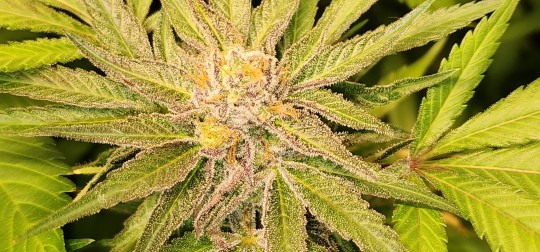
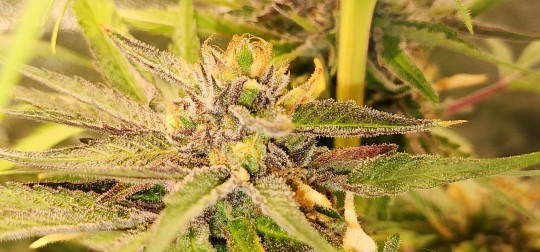
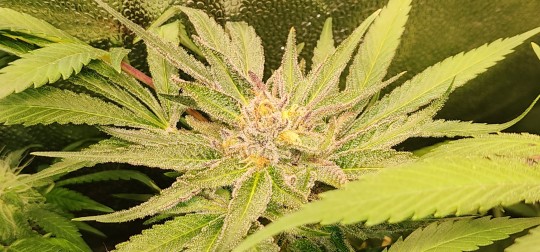
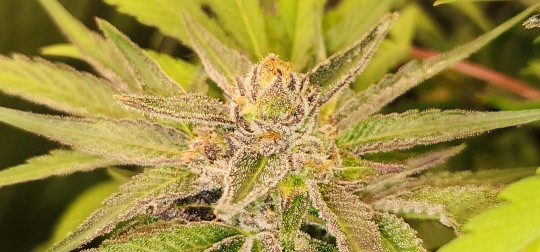

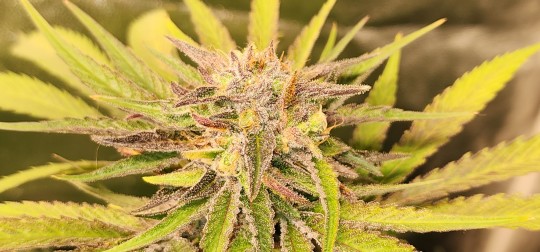

4 notes
·
View notes